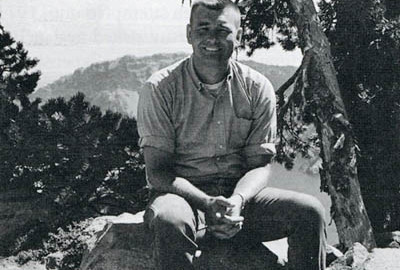Did you work with USGS personnel such as Charlie Bacon or Hans Nelson at any point?
No, I did not. I knew Charlie Bacon, of course, and I think I met Hans Nelson a couple times at meetings.
Did you initiate contact with Denny Smith’s office prior to 1982 (22)?
No, and I’d like to expand on that. What I’d like to do now is talk about what I found beginning in 1978. I was using the Secchi disk and photometer, and the data was showing me that there had been a substantial loss in the lake’s clarity. There was also a substantial change in the spectral properties of the lake. Initially I was trying to be a good scientist. When you’re a good scientist, you try to disprove your own hypothesis and you remain very skeptical of your data until you have enough to conclude something about it. At first I didn’t say anything about my findings, I just continued to take my measurements that summer. I noticed that the Secchi disk readings that I was taking in 1978 were about 30 percent less than those I had taken in 1968 – 69, at least on average. Certainly they were far less than the ones that Arthur Hasler took in the late 1930s. Haslerreported depths of forty meters in the late ’30s. I had one reading in 1968 or 69 that was like 32 meters, but that was taken during a storm, so really it wasn’t a meaningful measurement. I had Secchi disk readings similar to Hasler’s, and I had a world record Secchi disk of 44 meters in July, 1969. At that time I used a Secchi disk that was one meter in diameter. I was finding in 1978 none of my readings were greater than 3 1 or 32 meters.
These were with a smaller disk?
Right, a small disk. I used a big disk once, too, and that reading was about 10 meters less than the record, like 34 meters. All my readings were about 10 meters less than what they had been 10 years earlier. I also deployed the photometer and I found that blue light was being transmitted less than green light. What this suggests in limnology is that when you get a shift from greater transmission in the blue band width to greater transmission in the green band width is that you’re getting more particulate matter in the water, more suspended material. Where blue light is being transmitted the farthest occurs in very clear lakes and in the ocean, where there is very little particulate matter. In these very clear water bodies most of the light scattering is being done by molecules. Water molecules tend to scatter at the very short, or at the very deep blue or blue violet end of the spectrum. That is, at very short wave lengths. In other words, water molecules tend to scatter short wave length light, so when you look at Crater Lake you see this very deep blue color. That’s because what you are seeing is the back scattering of light of short wave length, light primarily or almost entirely scattered by water molecules. As you increase the concentration of suspended matter, you begin to see a shift from the deeper blue. There was a tendency more for the back scattering of the light to be closer to the green wavelength. I’m not sure I’m making myself clear, does that make sense to you?


